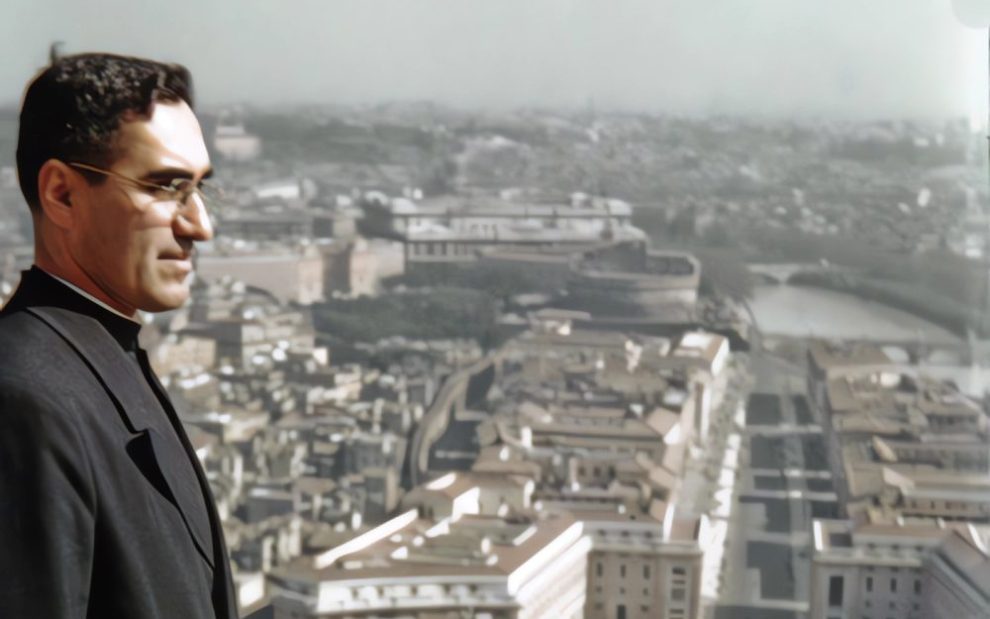The contemporary crisis of masculinity is often framed in reactionary terms—“men are lost,” “men are under attack,” “bring back real men.” Within Catholic discourse, these narratives are frequently coupled with appeals to “traditional” gender roles, and a nostalgic reassertion of patriarchal authority. As other writers have highlighted, there are serious issues with masculinity in the church, but few constructive ways to address them.
As opposed to strict visions of masculine people as either providers or aggressors, operating within a very limited aesthetic, we envision masculinity as something different: a unique way to be and see the world. Masculinity is not confined to men, either; it is experienced and embodied by genderqueer, intersex, and nonbinary people, as well as some women. Masculinity is less about a set of fixed attributes than about an overarching identity, whose meaning and aesthetics may vary between one community and another, but which is often connected with ideas about courage, strength, hard work, leadership, and authority.
With this in mind, we can look back at various men in church history who modeled healthy types of masculinity—who used strength or privilege to enact change while working for justice and inclusivity. Here are eight Catholic men—from the early church to the present day—whose lives reflect a virtuous masculinity. Together they challenge the assumption that masculinity must be defined by domination, exclusion, or rigidity.
St. Marinos the Monk (715–750)
Masculinity is often best exemplified by the people who fight for it, especially when transphobic societies refuse to affirm the masculinity of trans men. Marinos was assigned female at birth but adopted the name Marinos and entered a Lebanese monastery as a man in the 5th century. He entered the monastery with his father Eugenius.
“Abba Marinos,” as he was called by his fellow men, was at one time accused of fathering a child. He did not defend himself but rather was expelled from the monastery, lived outside its gates, and raised the child of an unmarried innkeeper’s daughter as his own. Although his anatomy would confirm his innocence after his death, his son grew up believing that Marinos was his father and eventually joined the monastery himself.
In recent years, Marinos has quickly become a saint of trans men; his feast day is celebrated on June 18 in the Catholic Church. He is one of a rich group of saints we would now call trans or nonbinary for being assigned female birth and then joining monasteries or leading armies as men. Saints like Marinos, courageous and resilient, offer hope to queer Catholics who grew up not knowing about their gender expansive saint ancestors.
St. Francis of Assisi (1182–1226)
St. Francis of Assisi was also a deeply complex saint. A mystic and founder of the Franciscans, he stands in stark contrast to capitalist, anti-emotional constructs of manhood today. He wrote poetry, wept uncontrollably when praying to Jesus, committed himself to poverty and service by renouncing his family’s wealth, and cared for and preached to animals. His model of a profound, emotional intimacy with God is one that counters the sexism and gender essentialism of conflating emotionality with femininity. It was through imitatio Christi, Hannah Ellingson writes, that saints like Francis defied medieval gender norms because as they mirrored how Christ superseded human constructs like gender.
Rev. Matthew Fox, formerly a member of the Dominican Order within the Catholic Church and later an Episcopal priest, situated St. Francis at the center of a sacred masculinity within the tradition of creation spirituality he founded. Fox writes that Francis’ most famous poem, “Brother Sun, Sister Moon,” exemplifies an “amazing balance of feminine along with the masculine.” St. Francis inspires a vision of healthy masculinity that is not threatened by the feminine, but embraces it.
St. John of the Cross (1542–1591)
Mysticism is a theme in the lives of many of the men featured in this piece; in fact, mysticism has often been an important medium for rebellion and liberation, as seen in Shannon Evans’ book The Mystics Would Like a Word(Penguin Random House). Mysticism also involves, often, taking a vulnerable and open relationship to God that some would view as feminine.
St. John of the Cross, a Spanish priest and Carmelite friar born in Castile, Spain, was a mystic. After his father and brother died, John, his brother Francisco, and his mom moved to Medine del Campo. There, John entered a school for poor children and later worked in a hospital, studying among the Jesuits. He entered the Carmelite Order in 1536 and joined the reform inspired by Teresa of Avila.
John was not threatened by Teresa’s leadership but collaborated with her in championing the primitive Rule of the Carmelites, a life of prayer, abstinence, and evangelization. The reforms were not received well, and he was even imprisoned for a time. In his dark prison cell, where he modeled a quiet courage and hope, he produced some of his greatest poetry, including that describing a mystical union with God in his text Spiritual Canticle. He escaped and later rose to positions of prominence in the church. John’s mysticism as well as his willingness to support Teresa’s leadership offer a model for a masculine confidence rooted in collaboration and communication, not dominance.
St. Martin de Porres (1579–1639)
Following St. Francis’s commitment to poverty, St. Martin de Porres Velazquez’s masculinity was rooted in a deep commitment to serve the poor. Porres was born as a mixed-race man in Lima, Peru. He was raised by his mother, a formerly enslaved woman, and experienced racism and intense poverty while a child. After apprenticing to a barber, he began his life as a lay brother at a Dominican priory. There, he worked as a farm laborer, tending the sick and dying, feeding the poor, and providing necessities of life to Indian, African, and Spanish individuals.
Known as the “Apostle of Charity,” Martin’s legacy is one of hard work, endurance, service of the poor, and a call for interracial unity. As he said, “Compassion, my dear Brother, is preferable to cleanliness. Reflect that with a little soap I can easily clean my bed covers, but even with a torrent of tears I would never wash from my soul the stain that my harshness towards the unfortunate would create.” Martin’s life exemplifies a masculine strength expressed in service to others.
Titus Brandsma (1881–1942)
Titus Brandsma’s action against hateful ideologies made him an enemy of the Nazi state: He lost his life urging Catholic publications to oppose Nazi law mandating the publication of Nazi documents. Brandsma was born in Friedsland in the Netherlands to devout Catholics; all of their children except for one daughter ended up joining religious orders. In September 1898, he became a Carmelite friar, adopting the name “Titus” in honor of his father. As a priest, he was also interested in Carmelite mysticism, connecting him to Saint John of the Cross, and as a professor of philosophy, committed to opposing Nazi ideology.
He was imprisoned by the Nazis in 1942, when he attempted to deliver a letter from the Conference of Dutch Bishops imploring Catholic newspapers not to print official Nazi documents. He was eventually transferred to the Dachau concentration camp and was killed in July 1942 from lethal injection as part of the camp’s medical experimentation on prisoners. His resolute courage in the fight against Nazism stands in stark contrast to the fragility of those who capitulate to authoritarians and oppressors.
St. Óscar Romero (1917–1980)
American Catholic prelate Fulton John Sheen, well known for his conservative radio program The Catholic Hour, once said that “Judas Iscariot would be the patron saint of social justice.” It’s a dangerous message, equating opposition to harmful power systems with the sins of disobedience and betrayal, when in reality, the work of social justice demands the virtues of courage and empathy. Sheen’s comments, made during the rise of the Civil Rights movement, were in dramatic opposition to the life and witness of his contemporary cleric, Monsignor Óscar Romero y Galdamez, archbishop of San Salvador.
Though not originally committed to social justice, Romero came to understand that his calling was to stand with the vulnerable against violent oppressors. He became a symbol of hope for marginalized Salvadorans, fighting social and economic injustice affecting the poorest families exploited by the ruling families of El Salvador.
Even after his friend Jesuit Father Rutillo Granda was brutally murdered, Romero found hope in liberation theology and the words of Father Gustavo Gutiérrez, “To know God is to do justice.” He was later assassinated while presiding over Mass at a hospital in 1980 but remains an inspiring figure among Salvadoran Catholics and those fighting oligarchical oppression. Romero stands as an exemplar of the kind of masculinity that is courageous in defense of the vulnerable.
Mychal Judge (1933–2001)
Father Mychal Judge was a Franciscan friar and priest who ministered to addicts and served as a chaplain to the New York City Fire Department at the time of the 9/11 attacks. When the plane collided with the World Trade Center, Judge rushed into the north tower along with the firefighters, praying and ministering to those trapped inside. While he was praying, he was struck and killed in the blast that exploded when the south tower collapsed. He was recognized as the first victim of 9/11.
After his death, close friends revealed that he was gay, and a long-term member of Dignity, a national LGBTQ+ Catholic movement. During his career Judge also showed up to the first LGBTQ+-inclusive St. Patrick’s Day Parade in Queens, which was openly boycotted by the church, in his collar. Although he is not canonized, many consider him an unofficial LGBTQ+ saint and an intercessor on behalf of victims in the 9/11 attacks and homophobic violence. Judge’s courage in the face of violence and service to society’s outcasts reveal him as a shining example of virtuous masculinity.
Pope Francis (1936–2025)
Pope Francis was widely viewed as one of the most emotionally available and sensitive pontiffs in recent times, receiving widespread praise for his rejection of the stiff and opulent aesthetics of the papacy as well as his devotion to the people on the margins.
Though in many ways Francis embraced more traditional gender expressions, he also modeled a loving fatherhood for the entire church and worked from his position of patriarchal authority to support and encourage the voices of the church that often go unheard: spearheading the synodal process that has often centered women’s role in the church as well as regularly meeting with people from the LGBTQ+ community, notably transgender people who have been under accelerated attacks in countries like the United States.
Pope Francis’ warmth and welcoming pastoral style coupled with his willingness to speak sternly about those who harm the vulnerable offer an alternative vision of fatherhood in contrast to models of stern, unemotional dominance.
Hope for a new (and old) masculinity
Diverse instantiations of masculinity are at the heart of what makes communities strong. As C.S. Lewis observed in his book Mere Christianity, “Sameness is to be found most among the most ‘natural’ men, not among those who surrender to Christ. How monotonously alike all the great tyrants and conquerors have been; how gloriously different are the saints.” This is an essential lesson for men today, who need guidance in finding their places in society and who often feel that there is only one right way to be a masculine person—mirroring the construct that there is one right way to be a woman.
Celebrating the many variations on healthy masculinity is especially urgent within the Catholic Church, where clericalism and gender essentialism continue to marginalize not only women and queer people, but men themselves. These eight holy men invite alternatives to rigid models of dominance born out of fear. Their lives of service to others and work for the common good offer an antidote to that fear and its accompanying loneliness, reminding men that God’s calls them to flourish in love and community.
Image: Wikimedia Commons, St. Óscar Romero












Add comment